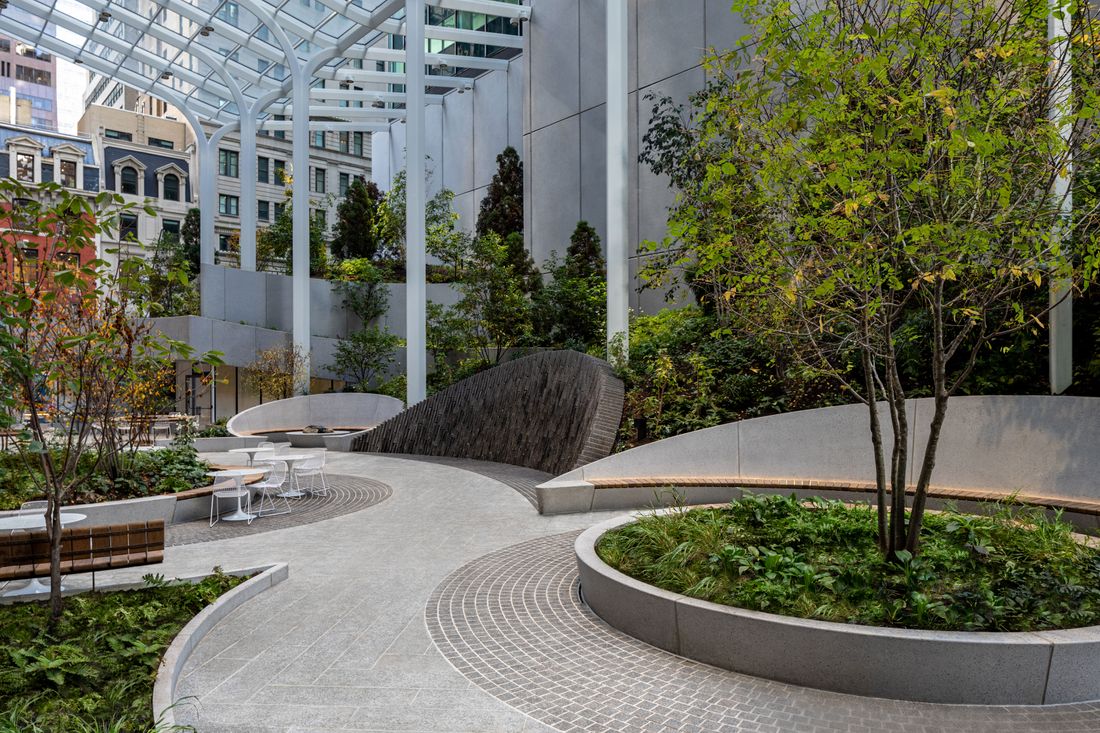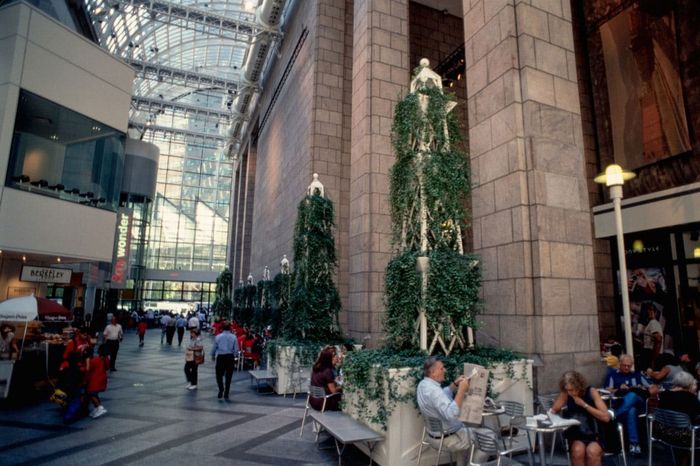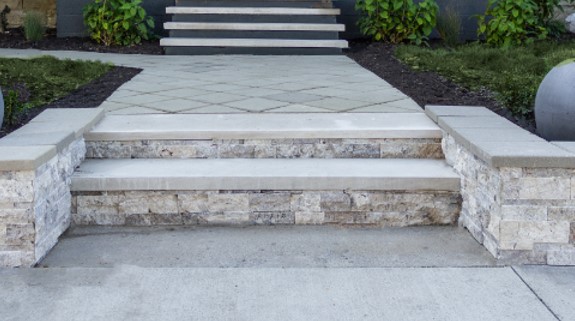
The plaza at 550 Madison is considered a “covered pedestrian passage,” but Snøhetta treated it more like a garden, with a meandering path that encourages people to slow down. The garden is divided into “rooms” with different features in each one, like a water feature inspired by Paley Park’s fountain, built-in benches, and movable chairs.
Photo: Barret Doherty
The new public plaza at 550 Madison, the Philip Johnson and John Burgee–designed pink granite skyscraper that looks like a Chippendale cabinet on top, is incredibly green, with fir trees, tall leafy shrubs, and delicate ferns cascading down a two-story-tall living roof that slopes into a hill. It’s almost like someone took a sliver of Central Park and stuck it in the heart of midtown. That abundance is meant to be an invitation. “Something as simple as seeing vegetation pushing out beyond a wall of buildings tells us that this space might be public,” says Michelle Delk, a landscape architect at Snøhetta, the firm heading up the renovation. If you venture inside the garden, it reveals a landscape that appears to fulfill that promise: hundreds of places to sit down (from built-in benches to white wire chairs at Saarinen Tulip tables), gender-neutral bathrooms, and a rock garden tucked under a portico. Standing by the plaza’s fountain, inspired by the one at nearby Paley Park, the sound of rushing water nearly drowns out the drone of traffic.
The new plaza is one of the most dramatic changes in a $300 million revitalization of the postmodern building led by the Olayan Group, which bought the building in 2016, and the architecture firm Snøhetta. It is, like many other plazas in midtown, a privately owned public space (POPS). For 30 years, it looked very different than it does today: It was enclosed and indoors. Between the bad art, fake-looking plants, and crowded seating, it was barely more than a glorified hallway between the building and the 10,000-square-foot Sony retail store and museum that took over the west side of the plaza. The decision to turn the POPS into a garden was part of plans dating back to 2017 to open the base of the skyscraper back up to the city around it. But the redesign isn’t just a goodwill gesture to bring more park space to midtown; it’s a real-estate play tailored for a moment when people are reluctant to return to the office and to the neighborhood itself. There’s a 16 percent vacancy rate in midtown offices, and developers and companies have loaded up on amenities to bring people back, from outdoor terraces to bike rooms with showers. Besides the interior redesign, Olayan is betting that fresh air, natural light, and trees will draw tenants to 550 Madison. “Buildings that focus on the health and wellness of the people in the building and energy efficiency tend to do better,” says Erik Horvat, the head of real estate at Olayan, referring to how well the building leases and the price per square foot that tenants are willing to pay. “It was super-important before COVID, and now it’s a must.” So far, it has drawn in Hermès, the investment firm Corsair, and the insurance firm Chubb, which all signed on as tenants before the building’s renovation wrapped up.
In The Social Life of Small Urban Spaces, the urbanist and sociologist William H. Whyte described what made public spaces successful: an abundance of inviting places to sit and relax, trees, water features, food vendors, artwork, and, most important, a lively atmosphere. “What attracts people most, it would appear, is other people,” he says. Whyte’s film and accompanying book came out in 1979 — at the same time Johnson was designing 550 Madison. It took a few decades for the building to catch up, but it’s finally getting there.
It’s a welcome twist that the long-running POPS program has coincided with the office-amenity race to yield a public space that might actually be pleasant. When POPS were introduced through zoning code in 1961, New York was going through a skyscraper boom. As developers crowded the city with ever-larger and taller buildings, planners looked for ways to hold onto light, air, and space at ground level for the public. They ended up outsourcing it to the private sector, which was eager to take advantage of the program. In exchange for constructing POPS, developers could add more floor space than zoning would normally allow. There are now nearly 600 POPS in the city — ranging from pocket parks to indoor atria and covered pedestrian passageways. However, most developers did the bare minimum, which “led to an enormous number of sterile, vacant, windswept, cold spaces that were essentially unusable,” says Jerold Kayden, a Harvard professor who has studied the history of POPS. Instead of including elements that would make us feel welcome, like comfortable tables and chairs, we’re often met with architectural barriers — spaces that are not visible from the street, that have uncomfortable seating, or are windswept. Even after a 1975 amendment prescribed more stringent design guidelines — mandating seating, for instance — most POPS remained uninviting and largely inaccessible. A 2000 study by the Municipal Art Society and Kayden found that 40 percent of all POPS weren’t usable by the public — a problem that still persists. Trump Tower, across the street from 550 Madison, is one such example; it routinely removes benches from its lobby and closes its atrium and fifth-floor terraces.
The public plaza in 2000 was completely enclosed.
Photo: Advocates for Privately-Owned Public Spaces/The Municipal Art Society of New York
In the beginning, most of the attention to the Johnson and Burgee skyscraper focused on the building’s form — from a front-page story in the Times praising its peaked pediment to writer Craig Unger describing it in this magazine as a “classical monument to corporate America that was capable of seducing the stodgiest board members at the same time that it titillated the trendiest postmodern architects.” The ground level — an entrance with a 116-foot-tall narrow arch over it with 60-foot-tall arcades on either side and a covered arcade behind the building — didn’t receive as much attention, but the reaction was more mixed. Then-Mayor Ed Koch liked the building’s “attractive plaza,” while critic Ada Louise Huxtable disapproved altogether, calling it an example of “the kind of jockeying with city regulations in which the developer demonstrates his skill in taking the most and giving the least” in “a familiar New York process,” she wrote. It was also criticized for being too drafty.
Johnson and Burgee’s original design for the plaza does feel a lot like the jockeying Huxtable described: It’s a vehicle to dial up the drama of the building above. As Johnson himself said, “We just lifted the entire building six stories off the ground, leaving the space below for pedestrians. The city liked that, and we got a more monumental building.” While the public spaces were quite open and cohesive, with a clear sight line from Madison Avenue to the covered passage behind the tower, it wasn’t a place you’d want to hang out. Johnson compared the base of 550 Madison to an Egyptian Hypostyle Hall — a cavernous space with very tall pillars placed closely together — but later admitted it was “cold and unfriendly.” It got worse when AT&T sold the building to Sony in the early ’90s. The electronics company wanted more retail on the ground floor and successfully made the case to the City Planning Department that enclosing the arcade would lead to a higher-quality public space, since it could be heated and cooled. The renovation, directed by Charles Gwathmey, was disastrous for the building’s relationship to the city around it. The canopy-covered passage became a hermetic space sealed off from life on the sidewalk, which, at the time, was perceived to be very dangerous and undesirable. The renovation brought more ground-floor retail to the Madison Avenue side of the building and dark, heavy windows to those once-monumental, open porticoes. When New York began to enjoy a renaissance of public spaces in the 2000s, 550 Madison remained a clunky symbol of a time when buildings turned their backs to the city.
The canopy, which covers the garden, collects rainwater, which is channeled into underground cisterns via the lean columns. A living roof covers the café and bathrooms and slopes into a hill. The garden is planted with regional trees, flowers, and shrubs to give the landscape variety through the seasons.
Because 550 Madison was landmarked during its recent renovation, historical elements are integrated into the plaza design. The herringbone pavers are original, and the circular motif is a nod to the porthole windows in the skyscraper’s façade.
The original design of 550 Madison’s public plaza by Philip Johnson offered clear sight lines from Madison Avenue to the pedestrian passage behind the skyscraper. A renovation in the 1990s blocked the view, but now, thanks to a new arched window in the lobby, passersby can see the Snøhetta-designed garden.
Photographs by Barret Doherty
For Delk and her team at Snøhetta, designing an open-air public plaza was an opportunity to draw people in where they were once shut out. They sought to break the monotony of midtown’s tall canyons with something more lush. And the Olayan Group wanted to create the effect of a miniature Bryant Park, encouraged by the astronomical increase in neighboring real-estate values once that green space was revitalized in the 1990s. When initial renderings of its renovation were released in 2017, preservationists were almost unanimously opposed to the proposal to replace the stone cladding on the lower floors with a glass-curtain wall. But they were more split on opening up the POPS. The Municipal Art Society wrote, in defense of the status quo, “The enclosed pedestrian space comes the closest of any through-block POPS in the city to evoke the nineteenth-century European arcade,” while Times critic Michael Kimmelman tweeted that, open or not, the plaza “has always been a failure at street level,” ultimately favoring the proposal to open it back up. The drastic changes spooked preservationists enough to call for landmarking the building, which received the designation in 2018. While the plans to rip out the façade were pulled back, the garden forged ahead and earned the approval of preservationists who believed that opening it up “gets back to the spirit” of Johnson and Burgee’s intent.
The new outdoor space at 550 Madison succeeds at doing this while offering up something different than other popular midtown POPS and public spaces nearby — including MoMA’s sculpture garden, Greenacre Park on 51st Street, and the bamboo-filled indoor atrium at 590 Madison. Unlike the flat planes that usually define corporate plazas, 550 Madison’s new design is, as Delk describes, “topographic,” with a hilly feature on the west side, which covers the roof of a café and the entrance to a parking garage under the building. The walkway has a slightly meandering path, which is more leisurely than the straight-shot lane that came before it, and signals to people passing through that this is a place to slow down. The plantings are also less formulaic; it’s filled with more than 3,000 regional plants and 50 trees by the horticulturalists at Phyto, including sweetbay magnolias that bloom in the summer and evergreens that offer foliage through winter — a much more naturalistic landscape than the typical plantings around midtown that swap neon-pink azaleas in summer for ornamental kale in the colder months.
Like Johnson’s design, Snøhetta’s uses height for a dramatic effect but addresses the sense of isolation that plagued the earlier design. A 60-foot-tall glass canopy with sinewy white columns — which is structurally lighter than the trussed barrel vault Johnson designed — now shelters the garden. At the same time, the canopy and the hills help the space feel more enclosed and human-scale — like an “embrace,” Delk says. The canopy is not just an aesthetic feature; it collects rainwater that’s stored in underground cisterns and contains lights that both illuminate the space for pedestrians and give the plants a little extra UV. Snøhetta designed tables around circular tree pits with the chairs facing inward — a detail that offers a sense of privacy (messy eaters, take note). “Before, there weren’t nooks and crannies,” Delk explains. “It was important for us to make seating where someone could see around but feel like their back is protected and that there are more intimate areas.”
But as lovely as it looks, will people come? Kayden, who has closely tracked the renovation, is skeptical about its cold-weather appeal. “There’s absolutely no question that for a large part of the year, this space will not be genuinely usable,” he says. “Could people sit outside in their coats? Of course they could. But on a cold day in New York, do they really wanna sit outside in their coats, or would they prefer to be in a wonderful indoor space?” (Snøhetta did incorporate an outdoor heater it calls the “hearth” that’s styled like a fireplace to help warm one of the seating areas.) Starting November 16, when it opens, we’ll see the first test of this open-air experiment. Judging by the winter crowds at the High Line, Little Island (when it’s not closed due to severe weather), and Bryant Park, chances look good; people will brave the cold if they think the experience is worth it.

